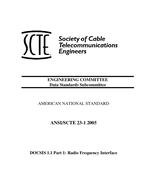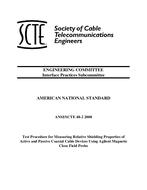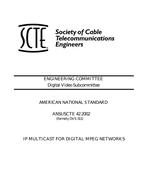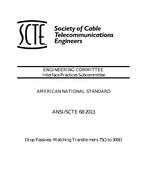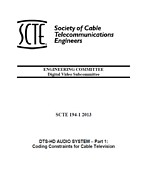Provide PDF Format
SCTE 23-1 2005
- DOCSIS 1.1 Part 1: Radio Frequency Interface
- standard by Society of Cable Telecommunication Engineers, 01/01/2005
- Publisher: SCTE
$25.00$50.00
This document defines the radio-frequency interface specifications for high-speed data-over-cable systems. Theywere developed for the benefit of the cable industry, including contributions by operators and vendors fromNorth America, Europe, and other regions.There are differences in the cable spectrum planning practices adopted for different networks in the world.Therefore two options for physical layer technology are included, which have equal priority and are not requiredto be inter-operable. One technology option is based on the downstream multi-programme television distributionthat is deployed in North America using 6 MHz channelling, and supports upstream transmission in the region5-42 MHz. The other technology option is based on the corresponding European multi-programme televisiondistribution and supports upstream in the region 5-65 MHz. Although both options have the same status, the firstoption was documented earlier and the second option introduced at a later time as an amendment, resulting in thedocument structure not reflecting this equal priority. The first of these options is defined in Sections 2, 4, 5,Appendix G and Appendix C.1.1.1, whereas the second is defined by replacing the content of those sectionswith the content of Appendix N Correspondingly, [ITU-T J.83-B], [NCTA] and [SMS] apply only to the firstoption, and [EN 300 429] only to the second. Compliance with this document requires compliance with one orother of these implementations, not with both. It is not required that equipment built to one option shall interoperatewith equipment built to the other.These optional physical layer technologies allow operators some flexibility within any frequency planning, EMCand safety requirements that are mandated for their area of operation. For example, the 6 MHz downstreambasedoption defined by Sections 2, 4, and 5 might be deployable within an 8 MHz channel plan. Compliancewith frequency planning and EMC requirements is not covered by this specification and remains the operators'responsibility. In this respect, [FCC15], [FCC76], and [EIA-S542] are relevant to North America and [EN50081-1], [EN 50082-1], [EN 50083-2], [EN 50083-7], and [EN 50083-10] are relevant to the EuropeanCommunity.The option of Sections 2, 4 and 5 together with Appendix G and Appendix C.1.1.1 is required to be backwardscompatible with an earlier version of that technology [DOCS9], whereas the option of Appendix N was notincluded in [DOCS9] and therefore is not required to be backwards compatible with [DOCS9].Any reference in this document to the transmission of television in the forward channel that is not consistent with[EN 300 429] is outside the normative scope as only [EN 300 429] is used for digital multi-program TVdistribution by cable in European applications.Requirements for safety are outside the scope of the present document. Safety standards for Europeanapplications are published by CENELEC.Note 1: Examples of such CENELEC product safety standards are [EN 60950] and [EN 50083-1].Note 2: For CENELEC safety categories of interfaces, see [EG 201 212].
Related Products
SCTE 48-2 2008
Test Procedure for Measuring Relative Shielding Properties of Active and Passive Coaxial Cable Devic..
$25.00 $50.00
SCTE 194-1 2013
DTS-HD AUDIO SYSTEM - Part 1: Coding Constraints for Cable Television..
$25.00 $50.00

